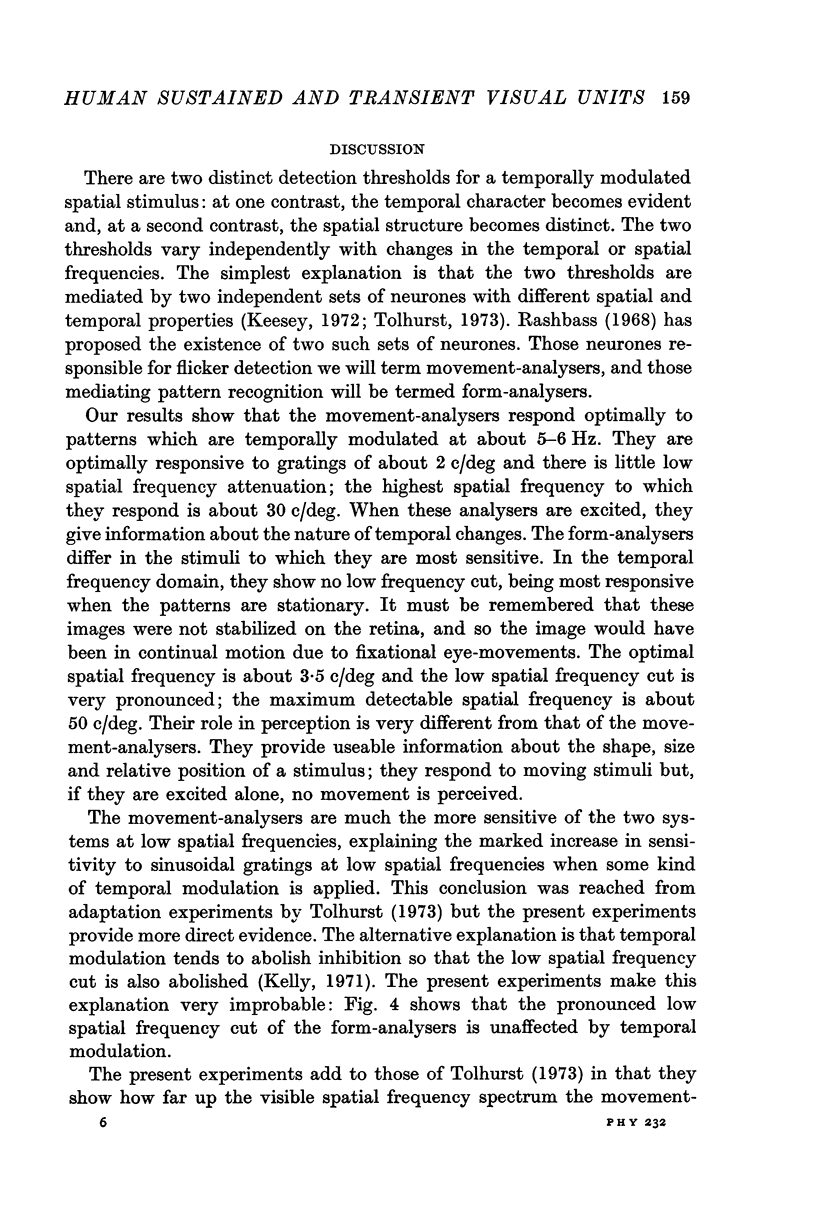Abstract
1. The sensitivity to temporally modulated sinusoidal gratings was determined. Two thresholds could be distinguished for the modulated gratings: the contrast at which flicker could be perceived and the contrast at which the spatial structure became distinct.
2. The flicker detection thresholds and pattern recognition threshold varied independently as functions of the spatial and temporal frequencies, suggesting that the two thresholds represent the activity of two independent systems of channels.
3. The channels detecting flicker prefer low and medium spatial frequencies. They have a pronounced decline in sensitivity at low temporal frequencies of sinusoidal modulation. They respond twice as well to gratings whose phase is alternated repetitively as to gratings turned on and off at the same rate.
4. The channels responsible for the discrimination of spatial structure are most responsive at high and medium spatial frequencies. There is no decline in sensitivity at low temporal frequencies. These channels respond equally well to alternating and on/off gratings up to about 8 Hz.
5. The temporal properties as revealed with sinusoidal modulation, suggest that the flicker-detecting channels would give transient responses to prolonged presentation of stimuli: the channels responsible for analysing the spatial structure would give sustained responses. The responses of the two types of channel to alternating and on/off gratings confirm this suggestion.
Full text
PDF













Selected References
These references are in PubMed. This may not be the complete list of references from this article.
- Cleland B. G., Dubin M. W., Levick W. R. Sustained and transient neurones in the cat's retina and lateral geniculate nucleus. J Physiol. 1971 Sep;217(2):473–496. doi: 10.1113/jphysiol.1971.sp009581. [DOI] [PMC free article] [PubMed] [Google Scholar]
- Enroth-Cugell C., Robson J. G. The contrast sensitivity of retinal ganglion cells of the cat. J Physiol. 1966 Dec;187(3):517–552. doi: 10.1113/jphysiol.1966.sp008107. [DOI] [PMC free article] [PubMed] [Google Scholar]
- Gouras P. Identification of cone mechanisms in monkey ganglion cells. J Physiol. 1968 Dec;199(3):533–547. doi: 10.1113/jphysiol.1968.sp008667. [DOI] [PMC free article] [PubMed] [Google Scholar]
- Keesey U. T. Flicker and pattern detection: a comparison of thresholds. J Opt Soc Am. 1972 Mar;62(3):446–448. doi: 10.1364/josa.62.000446. [DOI] [PubMed] [Google Scholar]
- Kelly D. H. Theory of flicker and transient responses. II. Counterphase gratings. J Opt Soc Am. 1971 May;61(5):632–640. doi: 10.1364/josa.61.000632. [DOI] [PubMed] [Google Scholar]
- Kulikowski J. J. Effect of eye movements on the contrast sensitivity of spatio-temporal patterns. Vision Res. 1971 Mar;11(3):261–273. doi: 10.1016/0042-6989(71)90190-8. [DOI] [PubMed] [Google Scholar]
- Kulikowski J. J. Some stimulus parameters affecting spatial and temporal resolution of human vision. Vision Res. 1971 Jan;11(1):83–93. doi: 10.1016/0042-6989(71)90206-9. [DOI] [PubMed] [Google Scholar]
- Rashbass C. Spatio-temporal interaction in visual resolution. J Physiol. 1968 May;196(2):102P–103P. [PubMed] [Google Scholar]
- Shapley R., Enroth-Cugell C., Bonds A. B., Kirby A. Gain control in the retina and retinal dynamics. Nature. 1972 Apr 14;236(5346):352–353. doi: 10.1038/236352a0. [DOI] [PubMed] [Google Scholar]
- Tolhurst D. J. Separate channels for the analysis of the shape and the movement of moving visual stimulus. J Physiol. 1973 Jun;231(3):385–402. doi: 10.1113/jphysiol.1973.sp010239. [DOI] [PMC free article] [PubMed] [Google Scholar]
- van Nes F. L., Koenderink J. J., Nas H., Bouman M. A. Spatiotemporal modulation transfer in the human eye. J Opt Soc Am. 1967 Sep;57(9):1082–1088. doi: 10.1364/josa.57.001082. [DOI] [PubMed] [Google Scholar]


